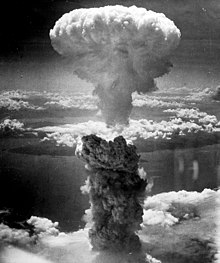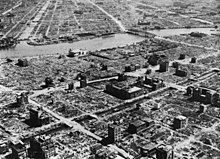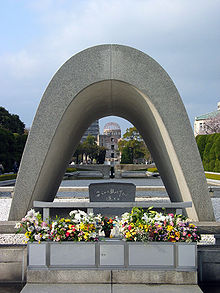Debate over the atomic bombings of Hiroshima and Nagasaki
"[2] Supporters of the bombings generally assert that they caused the Japanese surrender, preventing massive casualties on both sides in the planned invasion of Japan: Kyūshū was to be invaded in November 1945 and Honshū four months later.
[20] A widely cited estimate of five to ten million Japanese deaths came from a study by William Shockley and Quincy Wright; the upper figure was used by Assistant Secretary of War John J. McCloy, who characterized it as conservative.
[21] Some 400,000 additional Japanese deaths might have occurred in the expected Soviet invasion of Hokkaido, the northernmost of Japan's main islands,[22] An Air Force Association webpage states that "Millions of women, old men, and boys and girls had been trained to resist by such means as attacking with bamboo spears and strapping explosives to their bodies and throwing themselves under advancing tanks.
"[23] The AFA noted that "[t]he Japanese cabinet had approved a measure extending the draft to include men from ages fifteen to sixty and women from seventeen to forty-five (an additional 28 million people)".
In the Dutch East Indies, there was a "forced mobilization of some 4 million—although some estimates are as high as 10 million—romusha (manual labourers) ... About 270,000 romusha were sent to the Outer Islands and Japanese-held territories in Southeast Asia, where they joined other Asians in performing wartime construction projects.
Unlike the United States and Nazi Germany, over 90% of the Japanese war production was done in unmarked workshops and cottage industries which were widely dispersed within residential areas in cities and thus making them more extensively difficult to find and attack.
In addition, the dropping of high explosives with precision bombing was unable to penetrate Japan's dispersed industry, making it entirely impossible to destroy them without causing widespread damage to surrounding areas.
The city was also a communication center, an assembly area for combatants, a storage point, and had major industrial factories and workshops as well, and its air defenses consisted of five batteries of 7-cm and 8-cm (2.8 and 3.1 inch) anti-aircraft guns.
Kyūma said: "I now have come to accept in my mind that in order to end the war, it could not be helped (shikata ga nai) that an atomic bomb was dropped on Nagasaki and that countless numbers of people suffered great tragedy."
[24]Japanese militarism was aggravated by the Great Depression, and had resulted in countless assassinations of reformers attempting to check military power, among them Takahashi Korekiyo, Saitō Makoto, and Inukai Tsuyoshi.
[62] According to historian Richard B. Frank, The intercepts of Imperial Japanese Army and Navy messages disclosed without exception that Japan's armed forces were determined to fight a final Armageddon battle in the homeland against an Allied invasion.
[68] In the PBS documentary "Victory in the Pacific" (2005), broadcast in the American Experience series, historian Donald Miller argues, in the days after the declaration, the Emperor seemed more concerned with moving the Imperial Regalia of Japan to a secure location than with "the destruction of his country".
"[63] On 18 and 20 July 1945, Ambassador Sato cabled to Foreign Minister Togo, strongly advocating that Japan accept an unconditional surrender provided that the U.S. preserved the imperial house (keeping the emperor).
[73] History professor Robert James Maddox wrote: Another myth that has attained wide attention is that at least several of Truman's top military advisers later informed him that using atomic bombs against Japan would be militarily unnecessary or immoral, or both.
[74] Maddox also wrote, "Even after both bombs had fallen and Russia entered the war, Japanese militants insisted on such lenient peace terms that moderates knew there was no sense even transmitting them to the United States.
Once these coup attempts had failed, senior leaders of the air force and Navy ordered bombing and kamikaze raids on the U.S. fleet (in which some Japanese generals personally participated) to try to derail any possibility of peace.
[105][106][107] Dwight D. Eisenhower wrote in his memoir The White House Years: In 1945 Secretary of War Stimson, visiting my headquarters in Germany, informed me that our government was preparing to drop an atomic bomb on Japan.
Led by Dr. James Franck, seven scientists submitted a report to the Interim Committee (which advised the President) in May 1945, saying: If the United States were to be the first to release this new means of indiscriminate destruction upon mankind, she would sacrifice public support throughout the world, precipitate the race for armaments, and prejudice the possibility of reaching an international agreement on the future control of such weapons.
On 11 August 1945, the Japanese government filed an official protest over the atomic bombing to the U.S. State Department through the Swiss Legation in Tokyo, observing: Combatant and noncombatant men and women, old and young, are massacred without discrimination by the atmospheric pressure of the explosion, as well as by the radiating heat which result therefrom.
Japanese protests against U.S. desecration of international principles of war paired the use of the atomic bomb with the earlier firebombing, which massacred old people, women and children, destroying and burning down Shinto and Buddhist temples, schools, hospitals, living quarters, etc ...
[156] Alexander Werth, historian and BBC Eastern Front war correspondent, suggests that the nuclear bombing of Japan mainly served to demonstrate the new weapon in the most shocking way, virtually at the Soviet Union's doorstep, in order to prepare the political post-war field.
Tōgō wrote in his memoir that the Emperor "warned [him] that since we could no longer continue the struggle, now that a weapon of this devastating power was used against us, we should not let slip the opportunity [to end the war] by engaging in attempts to gain more favorable conditions".
Rather than concern for the costs and risks to the population, or even Japan's overall military weakness vis-a-vis the United States, the decisive factor was Japanese leaders' recognition that their strategy for holding the most important territory at issue—the home islands—could not succeed.
The attack by Soviet forces, smashing the Kwantung Army and liberating Manchuria, Northern Korea, Southern Sakhalin and the Kuril Islands, led to the rapid conclusion of the war in the Far East.
In his 2007 biography of Hirohito, Japanese historian Ikuhiko Hata wrote: The author has made it a habit, when meeting with former members of the Imperial Army and Navy, to ask which had the greater impact at the time: the atomic bombs or the Soviet entry into the war?
[207]A further argument, discussed under the rubric of "atomic diplomacy" and advanced in a 1965 book of that name by Gar Alperovitz, is that the bombings had as primary purpose to intimidate the Soviet Union and were the opening shots of the Cold War.
[210] In his memoirs, Truman wrote: "There were many reasons for my going to Potsdam, but the most urgent, to my mind, was to get from Stalin a personal reaffirmation of Russia's entry into the war against Japan, a matter which our military chiefs were most anxious to clinch.
[216] In a 2017 study conducted by political scientists Scott D. Sagan and Benjamin A. Valentino, respondents were asked if they would support the use of atomic force in a hypothetical situation that kills 100,000 Iranian civilians versus an invasion that would result in the deaths of 20,000 American soldiers.
[237][238] Russian Ambassador to Japan Mikhail Galuzin called the response a "shameful measure" and said, "I have no idea which country committed the horrific civilian genocide of dropping the atomic bombs".
On July 11, a Chinese military affairs commentary channel on Xigua Video argued that if Japan intervenes, China should make an exception to its no-first-use nuclear policy and strike the country until it surrenders.


(1) Olympic – the invasion of the southern island, Kyūshū ,
(2) Coronet – the invasion of the main island, Honshū .




